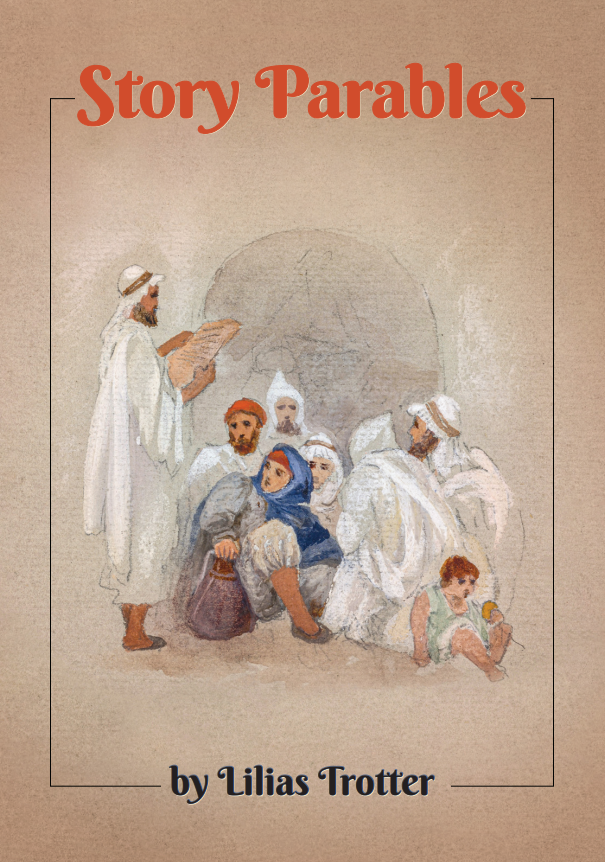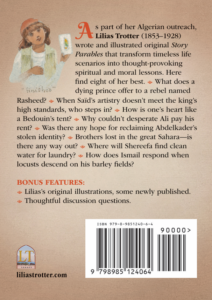STORY PARABLES
by Lilias Trotter


Yet another dream come true! The publication of Story Parables, a collection of eight timeless parables written by Lilias Trotter over one hundred years ago. This little volume (4.25″x6″) includes a selection of some of her finest story parables, written initially for her Arab friends, accompanied by original illustrations and individual “Interpretations.” The booklet concludes with optional questions (written by LTL board member, Bonnie Palmquist) to be used for personal reflection or group discussion.
Early on in Lilias’s years in Algeria, she became aware of the Arab people’s love of story – particularly parables – where a story was used to teach a specific truth encouraging a specific action. She resonated with that form of communication, often seeing spiritual meaning in the visible forms of nature. She began to “think” in parables, her diaries being laced with lessons learned from the natural world: “The daisies have been talking again,” “The word of the Lord came to me in a dandelion,” “A bee comforted me this morning.” This form of teaching was manifested in her early English devotional works, Parables of the Cross followed by Parables of the Christ-life.
Over the years, observing the use of parables among the Arab people to pass truths from generation to generation, she developed story parables in leaflets and booklets to transmit fundamental truths of Christianity. She was ahead of her times in developing literature with cultural relevance, using names and images familiar to their everyday lives, sensitively illustrated to satisfy the Eastern mind and eye. The stories dealt with topics familiar to her friends – the danger of traveling in the desert, the farmers’ fear of a swarm of locusts destroying their crops, the problem of finding clean water, the need to submit to those who ruled over them, the ornery but necessary camel – and many more. Throughout her lifetime, she and her colleagues wrote over 115 publications for the Arab people, scores of which were story parables. She eventually collaborated with The Niles Mission Press, in the publication of the same – some of which are in print to this day.
One might rightly ask: Why publish English translated story parables written over one hundred years ago in a place and time foreign to the typical reader? Is it simply a legacy piece meant to broaden our understanding of Lilias’s contribution to people of another culture and time? Certainly that is part of the mission of the Lilias Trotter Legacy: “to gather, preserve, and make accessible the written and artistic work of Lilias Trotter . . .” And, yes, it does give us a glimpse into Lilias’s remarkable ability to contextualize her offerings to the Arab people: story parables being a simple and direct approach to the ordinary everyday person in contrast to her sophisticated approach to the Sufi Mystic in her The Way of the Sevenfold Secret.
But we are convinced Story Parables does have relevance to our time. I quote from the Introduction: “Though written for an Eastern culture, they tell truths that apply today in a charming and colorful way that captures one’s attention by their very ‘different-ness.’ The truths are universal and timeless.” As C. S. Lewis wrote in regard to his own fictional works, “Stories allow us to steal past those watchful dragons.”
Let us suggest ways in which these simple stories might reach into the imaginations and hearts of today’s readers of all ages, as they did years ago with people of another culture and time:
- Cross-cultural curriculum for classical schools, homeschooling, or Sunday school – a window into deep spiritual truths, much as Aesop’s Fables taught young children moral lessons through short stories
- Vacation Bible School or missions’ conferences – possibly re-enacting or reading the parables for a jump start in the lessons
- Resource for teaching ESL (English as a Second Language) to Arab people
- Family devotions – encouraging inter-generational discussion
- Gift to an adult – to slip in a pocket or tuck in a purse (fresh eyes on old truths)
Bonnie Palmquist beautifully sums the possibilities in her Introduction to Story Parables: “I encourage you to read these little jewels and let them touch your heart. Then think of ways they could be used to communicate to your friends, whether from a different culture or just a different worldview. Let Lilias speak again, more than a hundred years after these were first written, in a unique and creative way.”
Story Parables in now available on Amazon. Buy one for yourself. Gift one to a friend. We look forward to hearing how you use this little volume.
CLICK TO PURCHASE:
Story Parables

